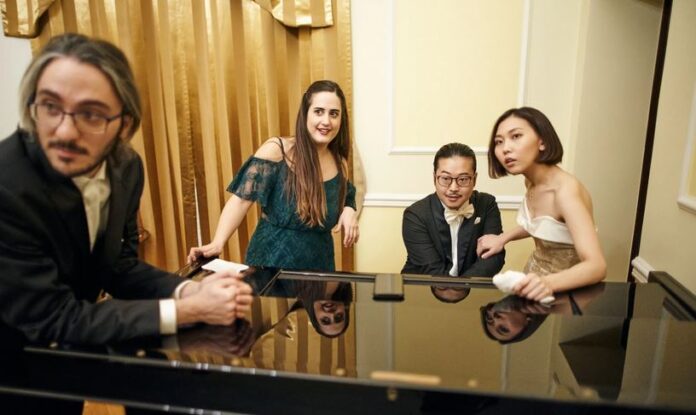By Jana Monji, AsAmNews Arts and Culture Critic
In the documentary Pianoforte, director Jake Piątek follows several young pianists who are part of the 18th edition of the famous International Chopin Piano Competition that took place in 2021. The competition and this documentary are an interesting study of representation of people of East Asian and Southeast Asian descent.
This competition is described as “the most important musical event in Poland and one of the most important musical events in the world” by the website XVII Konkurs Chopinowski Warszawa (18th Chopin Competition Warsaw). The first Fryderyk Chopin International Piano Competition took place in Warsaw in 1927 with eight countries represented by 26 pianists. Two more competitions were organized before World War II forced a hiatus. Competition resumed in 1949.
The competition takes place every five years. The documentary, Pianoforte, follows the 18th iteration which was originally scheduled for 2020, but was postponed until October 2021 due to the pandemic. According to an article in Variety, director Piątek wanted to do something different than other documentaries on the competition. “To me, the most interesting things happen before and after they play,” he told Variety.
Explaining how he determined which people he would follow, he said, “We asked 160 people to make a self-tape. I was interested in their story, not in whether they can actually win.” Of the 500 applicants, only 87 people made it into the preliminary rounds. Piątek noted in a YouTube video from the Chopin Institute that of those 160 people, he chose 40 to follow. You won’t see all those people in the documentary, but you will see Eva Gevorgyan (Russia/Armenia), Marcin Majchrowsk (Poland)i, Alexander Gadjiev (Italy/Slovenia), Hao Rao (China), Leonora Aremllini (Italy), and Michelle Candotti (Italy).
LATEST STORIES
Eva Gevorgyan and Hao Rao will finish in the top 12 where half of the competitors are of East Asian descent. Of the top four, two will be of East Asian descent–the eventual winner, Paris-born and Montreal-raised Bruce (Xiaoyu) Liu of Canada and Kyohei Sorita of Japan who tied for second with Italian Alexander Gadjiev.
In the 18th competition, 63 percent were of East Asian or Southeast Asian descent. While the director specifically told Variety that he “wasn’t trying to focus on the favorites, like Canada’s Bruce Liu” who went on to win, he did select Gadjiev who tied for second with Kyojei Sorita of Japan. He also chose Aremllini who finished fifth behind Aimi Kobayashi (Japan) and Jake Kuszik (Poland), who tied for fourth.
It’s notable that the two Canadians in the top 12 were both of East Asian descent (Liu and Toronto-native JJ Jun Li Bui), but also that all four Canadians in the competition were of East Asian descent (Eric Guo and Victoria Wong along with Qui and Liu).
The first person of Asian descent to place in the top three was Fou Ts’ong who placed third in 1955. In 1970, Mitsuko Uchida of Japan, was second and in 1980, Đặng Thái Sơn of Vietnam earned top honors over two Soviet Union pianists. The demographics of the last three competitions, however, seem to indicate a trend of increasing East Asian and Southeast Asian presence in the preliminary rounds. (For a more detailed history and rundown of East Asian and South East Asian presence, visit my blog, Age of the Geek.)
In the documentary “Pianoforte,” we do get a few glimpses of the eventual winner, Canadian Bruce Liu but it might have been interesting to hear from a prominent teacher of Liu’s who had previously won: Đặng Thái Sơn taught at the Université de Montréal for 20 years and Liu was one of his students.
The now 64-year-old Đặng Thái Sơn was one of the jurors at the 18th competition. Jury members recuse themselves from assessing a former or current student, but the judge might have had some insight of how things have changed over the decades.
It’s hard to second guess the director’s decisions, but if representation matters, then this documentary doesn’t provide subjects that reflect the actual demographics of the competitors nor has it given an indication of the talents that are coming out of East and Southeast Asia. It’s also different to be part of a continuing legacy for a Polish (and to a lesser degree, French) pianist than to be taking up a non-traditional musical instrument and repertoire. Pianoforte does , however, provide some understanding of the dedication and sacrifices required to place as well as the differences between male and female competitors during the rounds.
Pianoforte made its world premiere at the 2023 Sundance Film Festival.
For a longer discussion on this film, visit AgeOfTheGeek.org.
AsAmNews is published by the non-profit, Asian American Media Inc. Follow us on Facebook, X, Instagram, TikTok and YouTube. Please consider making a tax-deductible donation to support our efforts to produce diverse content about the AAPI communities. We are supported in part by funding provided by the State of California, administered by the California State Library in partnership with the California Department of Social Services and the California Commission on Asian and Pacific Islander American Affairs as part of the Stop the Hate program. To report a hate incident or hate crime and get support, go to CA vs Hate.








